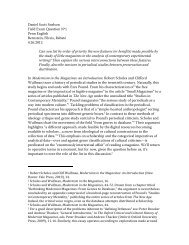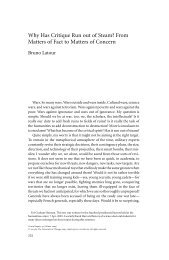Bruno Latour, Aramis, or the Love of Technology, PDF - Dss-edit.com
Bruno Latour, Aramis, or the Love of Technology, PDF - Dss-edit.com
Bruno Latour, Aramis, or the Love of Technology, PDF - Dss-edit.com
Create successful ePaper yourself
Turn your PDF publications into a flip-book with our unique Google optimized e-Paper software.
In 1976, on <strong>the</strong> o<strong>the</strong>r hand, it is <strong>com</strong>posed <strong>of</strong> hundreds <strong>of</strong> membra dis;ecfa,each <strong>of</strong> which is evolving in terms <strong>of</strong> its own alliances and prohibitions.The variable-reluctance mot<strong>or</strong> holds up, but not <strong>the</strong> stations on sidings; andnot <strong>the</strong> polystate. Matra sticks with it, but not Aerop<strong>or</strong>t de Paris, which haslong since dropped <strong>the</strong> whole thing. Finally, in 1988, <strong>the</strong>re's no longeranyone who can explain what constituted <strong>Aramis</strong>' unity, since it has beendismembered once again, since <strong>the</strong> teams have been disbanded and <strong>the</strong>research center destroyed, and since <strong>the</strong>re's talk <strong>of</strong> "spillover": <strong>the</strong> variable-reluctancemot<strong>or</strong> is now isolated, abstracted from <strong>the</strong> whole, savedfrom <strong>the</strong> shipwreck to be<strong>com</strong>e one <strong>of</strong> <strong>the</strong> positive elements <strong>of</strong> <strong>Aramis</strong>endowed retrospectively with a life <strong>of</strong> its own. "At least <strong>the</strong>re was <strong>the</strong>mot<strong>or</strong>ization-a great technological success, even if it's a little costly andhasn't yet found clients."To count <strong>the</strong>se successive states, a very peculiar arithmetic is required,since each element, by virtue <strong>of</strong> <strong>the</strong> pressure brought to bear on it,can be<strong>com</strong>e ei<strong>the</strong>r an autonomous element, <strong>or</strong> everything, <strong>or</strong> nothing,ei<strong>the</strong>r <strong>the</strong> <strong>com</strong>ponent <strong>or</strong> <strong>the</strong> recognizable part <strong>of</strong> a whole. The question <strong>of</strong>how many elements <strong>com</strong>pose a technological system cannot be answeredby <strong>or</strong>dinary arithmetic. When <strong>the</strong>re are breakdowns, accidents, strikes, <strong>the</strong><strong>com</strong>ponents separate into individuals and proliferate; <strong>the</strong>n, when <strong>the</strong> systemstarts up again, <strong>the</strong>y disappear, and literally do not count any longer.The lack <strong>of</strong> flexibility <strong>of</strong> <strong>the</strong> space shuttle Challenger's O-rings after a coldwave became apparent only after <strong>the</strong> explosion-from that point on, it wasnecessary to reckon with cold temperatures. * The lack <strong>of</strong> flexibility <strong>of</strong> <strong>the</strong>maintenance-shop w<strong>or</strong>kers in <strong>the</strong> Paris metro after an action by <strong>the</strong> CGT[Confederation Generale du Travail, a lab<strong>or</strong> union] became apparent onlyafter <strong>the</strong> long strike in 1988-from that point on, <strong>the</strong> w<strong>or</strong>kers had to bereckoned with. Bef<strong>or</strong>e <strong>the</strong> catastrophe, didn't it ever get cold at CapeKennedy? Bef<strong>or</strong>e <strong>the</strong> strike, weren't <strong>the</strong>re any bitter young non unionizedw<strong>or</strong>kers? The cold and <strong>the</strong> young w<strong>or</strong>kers were absent and present at <strong>the</strong>same time. Yes, it's a weird arithmetic that can't pin down <strong>the</strong> numbers.*Thomas F. Gieryn and Anne E. Figert, "Ingredients f<strong>or</strong> a The<strong>or</strong>y <strong>of</strong> Scienccin SOCiety: ORings, Ice Water, CClamps, Richard Feynmann and <strong>the</strong> Press," inS. Cozzens and T. Gieryn, eds., The<strong>or</strong>ies <strong>of</strong> Science in SOCiety (Bloomington: IndianaUniversity Press, 1990) . See also J. L. Adams, FIyin8 Buttresses, Entropy and ORin8s(Cambridge, Mass. : Harvard University Press, 1991).SHILLY·SHALLYING IN THe SEVENTIES









